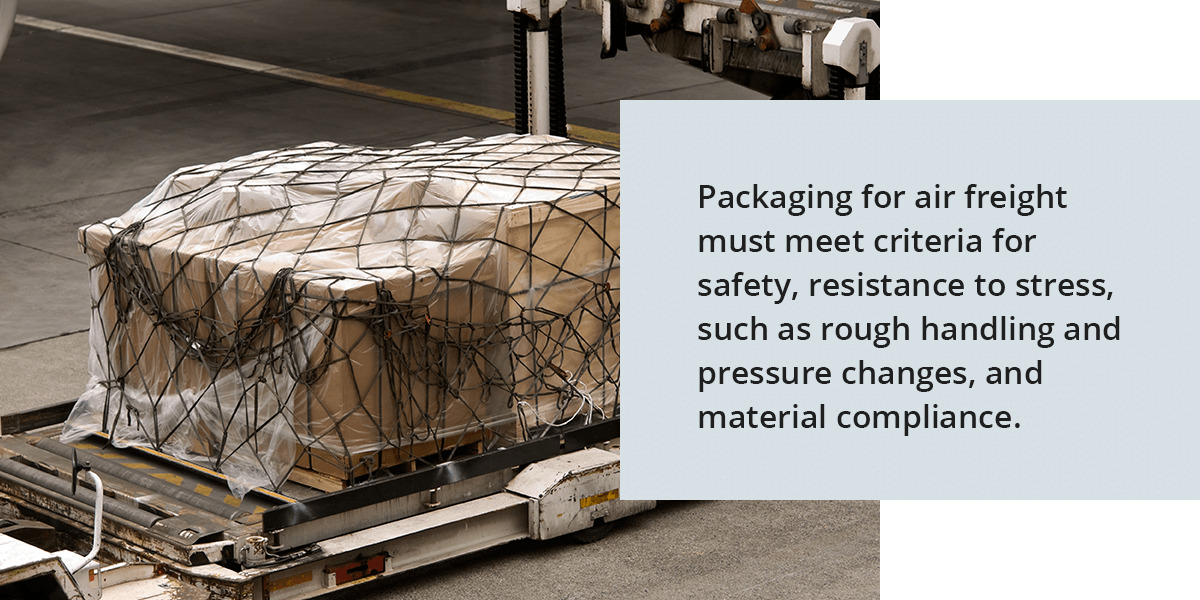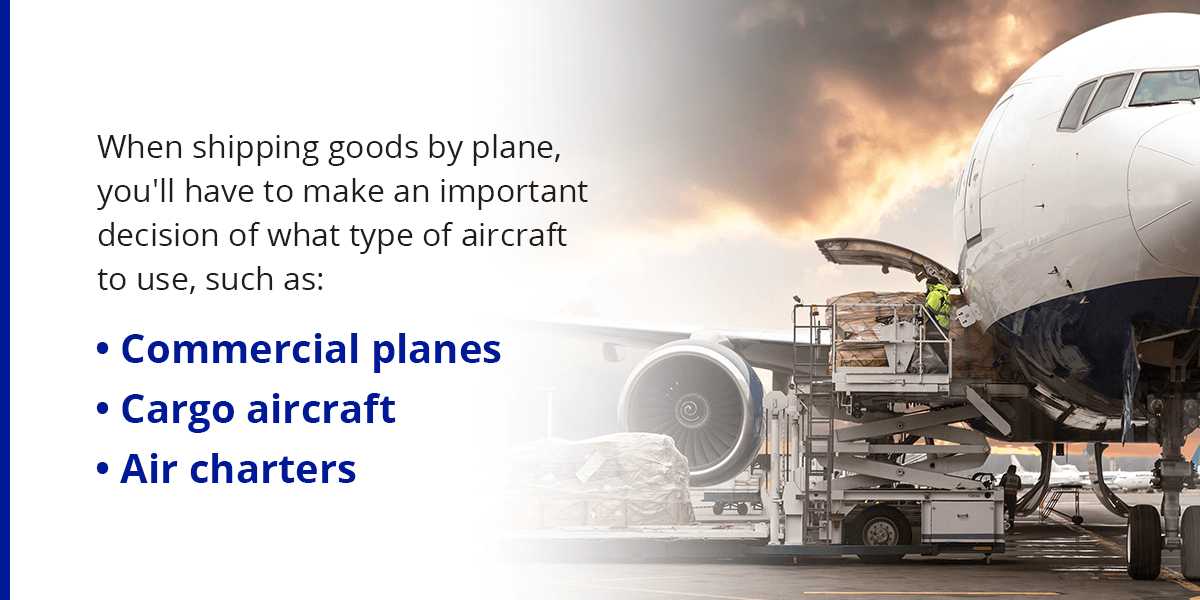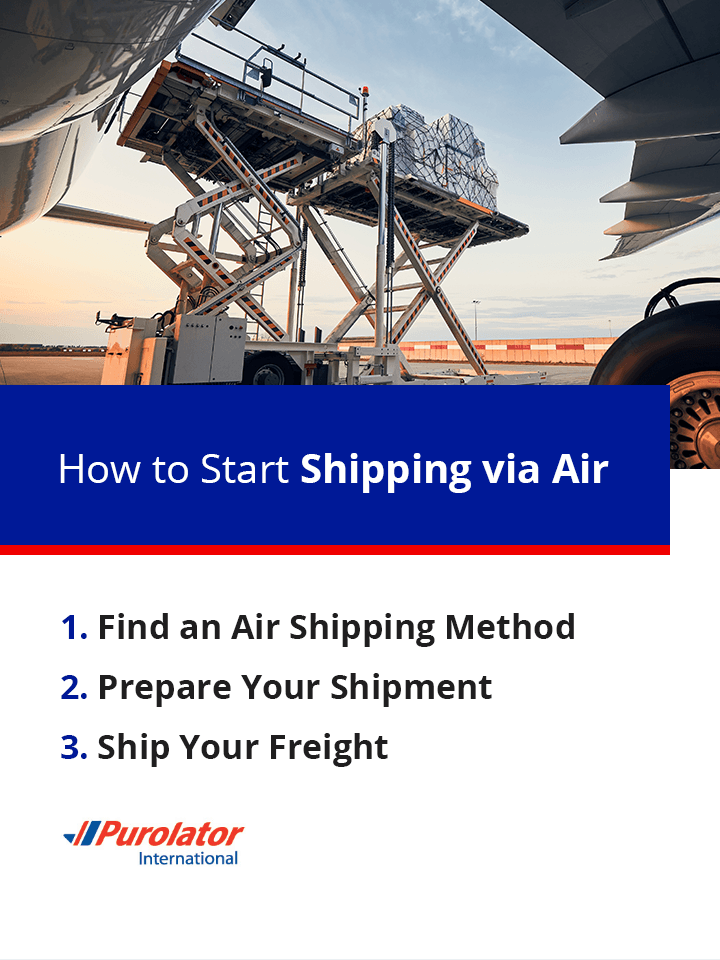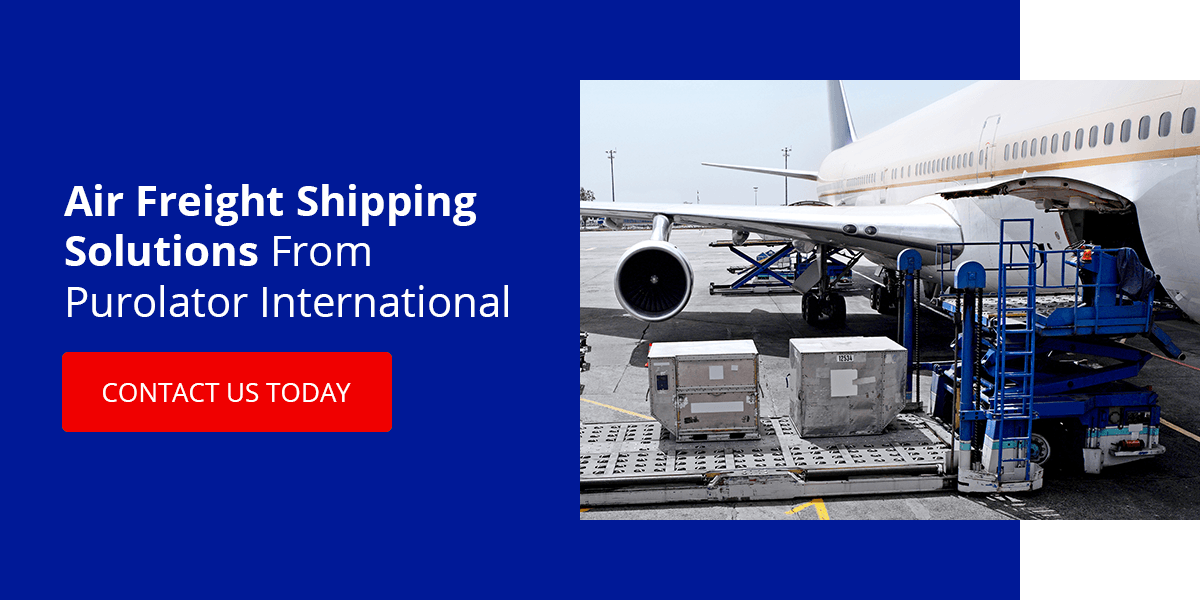Blog
Air Freight in 2021: What Manufacturers Need to Know

In 2021, a projected 63.1 million metric tons of freight will travel by aircraft worldwide. While shipments can travel by land, air or sea, air shipping is a fast, reliable and safe way to get cargo to its destination. While this shipping method can have a bit of a learning curve owing to the security and cargo space constraints governing the aviation industry, manufacturers can gain many advantages with air cargo shipping.
We’ve put together this helpful guide to teach you how to ship goods via plane and answer your biggest questions about air freight.
Air Freight Shipping Requirements
Air travel has many security requirements for passengers, and the same is true for freight. Because aviation has heightened security needs, air cargo has additional conditions and restrictions compared to other shipping methods like ship and truck transportation. Individual air carriers may impose additional packaging, size and weight requirements to meet their material handling needs and cargo space.
Some of those requirements include:
Packaging
Packaging for air freight must meet criteria for safety, resistance to stress, such as rough handling and pressure changes, and material compliance. Typical shipments traveling via air will be either packaged in a wooden crate or corrugated fiberboard boxes stacked on a standard wooden pallet. The packaging must withstand stacking and forklift handling. Irregularly shaped objects will often need to be palletized and secured to avoid shifting. Some of the rules and best practices to keep in mind include:
- Any shipment weighing 150 pounds or large enough to house a human must be locked or secured with four bands — two bands in each direction.
- Packaging must be tamper-proof, with any openings, holes or breaks sealed off to prevent foreign objects from being smuggled into the shipment.
- Treat corrugated fiberboard boxes as single-use only.
- Use plastic pallets or new, standard wooden pallets with a bottom board.
- Do not stack pallets with an overhand or use a pyramid stack that prevents items from being stacked on top.
- Any wood crates or pallets must meet International Plant Protection Convention (IPPC) standards and, to ensure packaging integrity, be Grade A, B or C plywood with limited knots, and have sound three-way corner construction.
- Pack fiberboard boxes tightly with filler and dunnage to help them stand up to stacking and rough handling.
Restricted Items
Due to security concerns, several items cannot be shipped via commercial airlines and, therefore, need ground or boat transportation. Those restricted items include:
- Explosives, including fireworks and detonating fuses.
- Flammables in either liquid or solid form.
- Gases such as dry ice, compressed gas, fire extinguishers, gas lighters and aerosols.
- Toxic items such as pesticides.
- Biological products and waste, including medical waste and pathogens.
- Other items that present dangers to the public.
Hazardous materials (HAZMAT) can ship via air freight, but not as air cargo on commercial planes. To ship dangerous goods, you must identify the hazards, contain them and use correct hazard communication. The Department of Transportation identifies nine classes of hazardous goods, and you must follow the guidelines and restrictions for air transport, including the required labeling. As a new requirement in 2021, Class 9 materials must feature one of two labels, featuring a white diamond with vertical stripes on the upper half.
Individual carriers and airlines may place additional restrictions on the items they will transport.
Size and Weight
Most major airports have plenty of flights going to and from major shipping destinations every day, so it’s easy to ship large amounts of goods. However, a plane’s cargo space can vary by the type and size of the plane, so many carriers will place restrictions on the size and weight of your shipments. For example, wide-bodied aircraft will be able to fit more and larger cargo than narrow-bodied aircraft.
The size and weight restrictions will depend on the individual carrier, so make sure you talk with your carrier or freight forwarder about the size and weights of the shipments you’re transporting.
Popular Air Shipping Options
When shipping goods by plane, you’ll have to make an important decision of what type of aircraft to use, such as:
- Commercial planes: Commercial planes are an economical choice for smaller shipments. These goods require either pallets or shipping containers and will travel in the cargo hold of a passenger airplane. Because cargo is traveling with passengers, commercial air cargo faces additional safety restrictions and stricter size and weight limits.
- Cargo aircraft: Cargo aircraft can accommodate anything from small pallets to large machinery. You can fit a larger shipment on a cargo aircraft and face fewer security restrictions. You may also ship HAZMAT via cargo planes.
- Air charters: Time-sensitive deliveries may ship via air charters. Chartered aircraft give shippers access to the entire plane and can access a direct route to the destination. Chartered aircraft also allow for direct shipping to remote locations. Because they’re the best method for meeting a tight delivery window, they’re often used in the energy, mining and automotive sectors. Sporting events, product launches and movie shoots may also charter aircraft to deliver shipments quickly.
Once you choose your transport method, you’ll also have the option to choose your delivery speed. At the fastest speed, you can have your shipment out the same day or the next flight out. Other than chartering a plane, this is the quickest option. You can also choose next-day or two-day air for domestic flights. For less urgent deliveries, you might select deferred air, in which you wait for space to become available on an aircraft.
If you choose deferred air for an international flight, you can typically expect your delivery to arrive in three to five days. A faster option for international flights is express delivery, where your goods can arrive at the destination in two to three days.
How to Start Shipping via Air
Besides some of the unique considerations that come with air transportation, shipping air freight is similar to shipping freight by truck or by boat. Follow these steps to start shipping goods by air:
1. Find an Air Shipping Method
Your first step is to find an air shipping service that works for your company and your shipment. It’s common to work with a freight forwarder during this process. A logistics provider can coordinate ground transportation to the airport, coordinate pickup in the destination airport and take care of all international customs considerations along the way.
Another option is to seek air courier shipping, where one company will personally collect your initial pickup and final delivery and clear customs at the origin and destination airports for you. The downside of working with a courier is that your shipment often has to work into their existing delivery schedules and routes. Whereas, when you work with a freight forwarder, they’ll coordinate the ground and air transportation that fits your delivery windows best.
Other than that, consider whether cost or delivery speed is most important to you. Any carrier will charge more for faster shipments. If you’re working with a freight forwarder, you’ll have a representative who can sit down and compare rates with you and help you decide which shipping option has the price and schedule that fits your needs. If you choose to work with an air courier, you’ll have to compare their services head to head and decide what works best for you.
2. Prepare Your Shipment
First, consider the best way to pack your shipment given its size and air cargo requirements for packaging. You can talk to your freight forwarder or selected carrier about packaging recommendations. If it’s a notably bulky item, you might strap it down to a pallet and use a plastic covering or shrink-wrap. Otherwise, select a fiberboard box or wooden crate to protect your shipment. Be sure to fill the container with plenty of padding to prevent damage to your cargo.
Size and weight will affect the pricing for most air cargo, so it’s essential to measure your freight after packaging it — particularly the chargeable weight. Carriers may charge you based on the actual weight of your cargo or by the volumetric or dimensional weight. Typically, they choose the higher of the two numbers to determine how much to charge:
- Calculating gross weight: You’ll want to weigh the package itself and the pallet to find your gross weight. Convert to kilograms for international shipments.
- Calculating volumetric weight: Carriers that use volumetric weight charge you primarily by the amount of space your cargo takes up. To find dimensional weight, you’ll need to know your freight carrier’s minimum air cubic conversion factor. Multiply the length, width and height of your package by the minimum air cubic conversion factor to find your volumetric weight. If your shipment is not evenly shaped, take the length, width and height from the largest points. Usually, a lightweight item that takes up a lot of space will be charged by the volumetric weight.
3. Ship Your Freight
Next, you can ship your freight according to the arrangements you’ve made. If you’re working with a freight forwarder, they should tell you when to expect a carrier at your warehouse to pick up your shipment. Otherwise, coordinate with your carrier to determine whether they will come to pick up the load or if you should bring it to their facility.
Before your shipment goes out, you must declare its value. Your carrier will use it to determine their liability, while customs will use it to determine your duties and taxes. On your commercial invoice, declare the actual price you paid for your goods rather than the intended resale price. You’ll also want to include a detailed description of your shipment. When shipping internationally, work with your freight forwarder to learn what other paperwork you’ll need, as it can vary by country.
Finally, consider investing in air cargo insurance. Either the buyer or seller of the shipped goods may invest in air cargo insurance for extra protection. It usually offers partial coverage for damaged, destroyed or lost items during transit. It may even cover flight delays. While the air carrier will likely offer a minimal amount of insurance on any freight, you may want to buy third-party freight insurance to increase your coverage depending on what you’re shipping. Your freight forwarder can recommend coverage options and help you understand what kind of insurance you need.
Which Industries Benefit Most From Air Shipping?
Many industries rely on air freight because it’s one of the fastest ways to get shipments to their destinations. While marine cargo is how most goods ship internationally, it’s generally slow. Air freight, however, can travel anywhere in the world in a matter of days. Because the method is so fast and reliable, companies that ship by air can keep smaller amounts of inventory while meeting tighter deadlines. So, they can save on warehousing space.
Air shipping also has an incredibly high capacity due to the frequency of flights traveling to most shipping destinations. If one plane runs out of space, there’s usually another flight several hours later with the capacity needed.
Another advantage of air shipping is the added protection. While the Transportation Security Administration (TSA) can make preparing shipments for a flight more challenging, they also serve to protect your packages once they’re at the airport, preventing theft.
While these advantages apply to many industries, air cargo’s high cost makes it better suited for lower shipping volumes and lightweight items. Some manufacturing sectors that benefit most from air shipping include:
Electronics
Electronics are generally lightweight, high-value, low-volume goods, making them an excellent match for air freight. Electronics like watches, tablets, microchips and laptops do particularly well with air freight.
Apparel
The apparel industry has a short product lifecycle, and success depends on the speed to market. Air freight offers two distinct advantages in the apparel industry. Many products have a short window where they are in season, and air shipping is the best way to keep these items in stock while they are still popular. Luckily apparel is generally lightweight, which makes air cargo a viable option to meet this need.
The other advantage is that fashion trends are unpredictable. Air freight can get new items to market quickly so apparel brands and retailers can determine what sells well and what has staying power. Once they have enough data to predict demand, they can coordinate a more affordable shipping method for regular replenishments.
Pharmaceuticals
The medical and pharmaceutical industry also has some unique constraints that make air travel more viable. Many products, such as vaccines and medications, must be kept at a specific temperature. The shorter the travel time, the easier it is to keep the items frozen or refrigerated, which reduces spoilage. Pharmaceuticals are usually extremely valuable while having a small gross and volumetric weight that makes them a good match for air shipping.
Contract Manufacturing
Contract manufacturers use air shipping to send samples and prototypes to their customers. Since their customers need to approve the designs before the manufacturers can initiate the full production run, air freight speeds up the process. They can get the product into their customers’ hands in a matter of days. This is especially time-efficient when they go through several rounds of changes before the final approval.
Air freight’s speed and reliability also come in handy for product launches when there’s a hard deadline for the shipment’s arrival.
Important Cost Considerations for Air Freight
While air freight offers a lot of benefits, it’s usually the most expensive form of shipping. The World Bank estimates that it’s four to five times more expensive than ground transportation and 12 to 16 times more costly than ocean freight. The high price of jet fuel is the main contributor to these costs. Short distances are typically priced higher per mile than long-haul distances. Taking off and descending require more energy, so when they take up a higher percentage of the journey, costs increase.
Carriers use the chargeable weight, or the larger number of gross or volumetric weight, to determine your general rate. Individual carriers and airlines set their rates based on a few parameters, and you’ll find varying rates for any shipment by looking at several airlines. Some other factors that affect the cost of air freight include:
- Fuel surcharges.
- Door-to-door costs such as transportation to and from the airports and customs clearance fees.
- Airline handling fees.
- Surcharges for specialized containers.
- Shipping speeds.
Air Freight Shipping Solutions From Purolator International
Purolator International specializes in shipping your cargo from the United States to Canada, whether by air, land or sea. We can help you determine whether air freight or another form of transportation is best for your shipment and act as your freight forwarder and customs broker to make shipping by plane seamless.
With our unparalleled cross-border experience, you can send air cargo to Canada as easily as you do in the U.S. We can coordinate your door-to-door shipping needs, meaning we can book ground transportation to the airport and have a carrier ready for pickup at your destination airport. We can get your shipment to any address in Canada, and with Expedited Forwarding and Elite Service shipping, you can get your freight on one of our dedicated flights to Canada.
We offer air cargo services to Canada and can even assist you in shipping global air freight. To discuss your next shipment and ask questions about our air freight services, contact the Purolator International team today.



